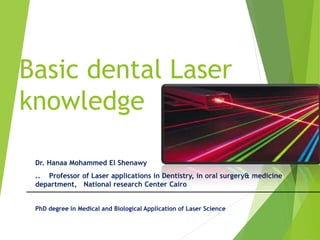This document provides an overview of basic dental laser knowledge. It discusses the history and fundamentals of dental lasers, including laser physics and the electromagnetic spectrum. It describes how a laser works and the key components of a laser system. Common laser types used in dentistry are explained, including their active media, wavelengths, delivery systems and tissue interactions. Applications of lasers in endodontics, operative dentistry and other areas are also mentioned. Safety considerations for dental lasers are noted.






























































































































![Laser basics[26239].pptx](https://image.slidesharecdn.com/laserbasics26239-231026124741-3b010082/85/Laser-basics-26239-pptx-127-320.jpg)